

Qualitative Research Is Always Biased – Karina. As a qualitative UX researcher at Meetup, Twitter, and now Foursquare, I’ve spent thousands of hours thinking about biases in qualitative research.
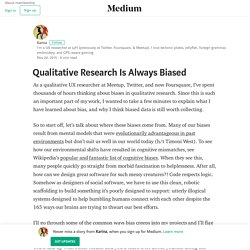
Since this is such an important part of my work, I wanted to take a few minutes to explain what I have learned about bias, and why I think biased data is still worth collecting. So to start off, let’s talk about where these biases come from. Many of our biases result from mental models that were evolutionarily advantageous in past environments but don’t suit us well in our world today (h/t Timoni West). To see how our environmental shifts have resulted in cognitive mismatches, see Wikipedia’s popular and fantastic list of cognitive biases. When they see this, many people quickly go straight from morbid fascination to helplessness. I’ll go through some of the common ways bias creeps into my projects and I’ll flag what I’ve learned to do over the years to produce results I can still believe in. Definition: Bias. Visual Cues & Bias in Qualitative Research. The Darshan Mehta (iResearch) and Lynda Maddox article “Focus Groups: Traditional vs.
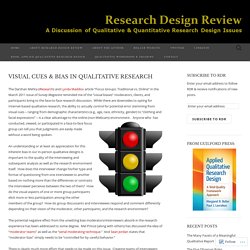
Online” in the March 2011 issue of Survey Magazine reminded me of the “visual biases” moderators, clients, and participants bring to the face-to-face research discussion. While there are downsides to opting for Internet-based qualitative research, the ability to actually control for potential error stemming from visual cues – ranging from demographic characteristics (e.g., age, race, ethnicity, gender) to “clothing and facial expressions” – is a clear advantage to the online (non-Webcam) environment. Anyone who has conducted, viewed, or participated in a face-to-face focus group can tell you that judgments are easily made without a word being spoken. Qualitative Research Bias - How to Recognize It. In qualitative research, bias affects the validity and reliability of findings, and consequently affects business decisions.

Bias distorts truth. Bias slants and skews data in qualitative marketing research. In marketing research, bias is inevitable. You need to recognize bias and reduce it, or at least be aware of it. Paying Attention to Bias in Qualitative Research: A Message to Marketing Researchers (& Clients) Researchers of all ilk care about bias and how it may creep into their research designs resulting in measurement error.
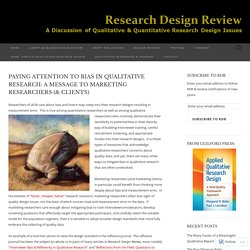
This is true among quantitative researchers as well as among qualitative researchers who routinely demonstrate their sensitivity to potential bias in their data by way of building interviewer training, careful recruitment screening, and appropriate modes into their research designs. It is these types of measures that acknowledge qualitative researchers’ concerns about quality data; and yet, there are many other ways to mitigate bias in qualitative research that are often overlooked. Marketing researchers (and marketing clients) in particular could benefit from thinking more deeply about bias and measurement error. In the interest of “faster, cheaper, better” research solutions, marketing researchers often lose sight of quality design issues, not the least of which concern bias and measurement error in the data. The humanness in all of us is worthy of reflection. "Bias in Qualitative Research: Voices from an Online Classroom" by Beloo Mehra.
Abstract.

Error, bias and validity in qualitative research: Educational Action Research: Vol 5, No 1. Avoiding bias in qualitative data analysis – Baseline Help Center. The nature of qualitative data makes it difficult, if not impossible, for the person doing the analysis to separate himself or herself from the data.
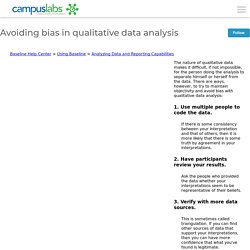
There are ways, however, to try to maintain objectivity and avoid bias with qualitative data analysis: 1. Use multiple people to code the data. If there is some consistency between your interpretation and that of others, then it is more likely that there is some truth by agreement in your interpretations. 2. Ask the people who provided the data whether your interpretations seem to be representative of their beliefs. 3. This is sometimes called triangulation. 4. Consider whether there are other reasons why you obtained your data. 5.
Ask others to review your conclusions. Interviewer Bias & Reflexivity in Qualitative Research. Research design of any sort has to grapple with the pesky issue of bias or the potential distortion of research outcomes due to unintended influences from the researcher as well as research participants.

This is a particularly critical issue in qualitative research where interviewers (and moderators) take extraordinary efforts to establish strong relationships with their interviewees (and group participants) in order to delve deeply into the subject matter. The importance of considering the implications from undo prejudices in qualitative research was discussed in the April 2011 Research Design Review post, “Visual Cues & Bias in Qualitative Research,” which emphasized that “there is clearly much more effort that needs to be made on this issue.” Reflexivity and, specifically, the reflexive journal is one such effort that addresses the distortions or preconceptions researchers unwittingly introduce in their qualitative designs.
Are We There Yet? Data Saturation in Qualitative Research. Bias and Validity Threats to Qualitative Research - John Latham. On 23 August 2004 in Athens, Russia’s Aleksei Nemov put forth a crowd-pleasing Olympic Men’s High Bar routine.
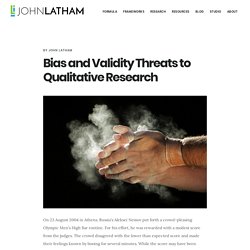
For his effort, he was rewarded with a modest score from the judges. The crowd disagreed with the lower than expected score and made their feelings known by booing for several minutes. While the score may have been lower than Aleksei deserved, appearing to let the crowd influence the score did not increase our confidence in the accuracy of the score. Appearing to bend to the crowd’s wishes, after a discussion, the judges revised Aleksei’s score slightly upward but not enough to put him in medal contention. What can we learn from Aleksei Nemov’s experience in Athens? Preconceived Notions – Bias The judges and the crowd both had preconceived notions about the gymnast. The judges also have other pre-existing factors influencing their evaluation. Three Ways Online Qualitative Research Helps Minimize Bias - Upwords. We are so imperfect.
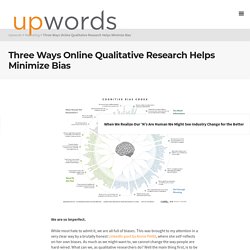
While most hate to admit it, we are all full of biases. This was brought to my attention in a very clear way by a brutally honest LinkedIn post by Annie Pettit, where she self-reflects on her own biases. As much as we might want to, we cannot change the way people are hard-wired. What can we, as qualitative researchers do? Well the main thing first, is to be aware that bias exists.
We can address the imperfection. Here are three types of bias along with some tips we follow at Upwords to minimize each. Participant Expectations and Researcher Bias in Qualitative Research Flashcards. How to Reduce Researcher Bias in Social Research. In conducting research, being partial can lead to faulty conclusions.
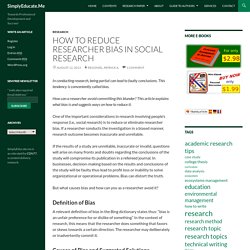
This tendency is conveniently called bias. How can a researcher avoid committing this blunder? This article explains what bias is and suggests ways on how to reduce it. Extent, Awareness and Perception of Dissemination Bias in Qualitative Research: An Explorative Survey. Abstract Background Qualitative research findings are increasingly used to inform decision-making. Research has indicated that not all quantitative research on the effects of interventions is disseminated or published. The extent to which qualitative researchers also systematically underreport or fail to publish certain types of research findings, and the impact this may have, has received little attention. Methods.